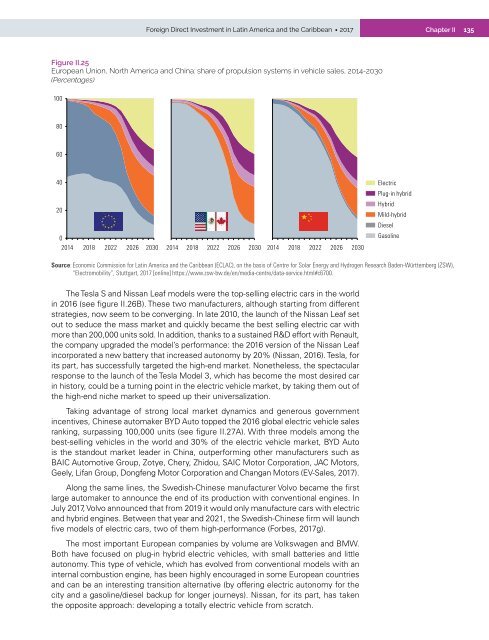Foreign Direct Investment in Latin America and the Caribbean 2017
This publication sets out and analyses the main foreign direct investment (FDI) trends in the countries of Latin America and the Caribbean. The 2017 edition shows that the region is at a difficult juncture. FDI inflows declined by 7.9% in 2016, to US$ 167.043 billion, representing a cumulative fall of 17.0% since the peak in 2011. The fall in commodity prices continues to affect investments in natural resources, sluggish economic growth in several countries has slowed the flow of market-seeking capital, and the global backdrop of technological sophistication and expansion of the digital economy has concentrated transnational investments in developed economies.
This publication sets out and analyses the main foreign direct investment (FDI) trends in the countries of Latin America and the Caribbean. The 2017 edition shows that the region is at a difficult juncture. FDI inflows declined by 7.9% in 2016, to US$ 167.043 billion, representing a cumulative fall of 17.0% since the peak in 2011. The fall in commodity prices continues to affect investments in natural resources, sluggish economic growth in several countries has slowed the flow of market-seeking capital, and the global backdrop of technological sophistication and expansion of the digital economy has concentrated transnational investments in developed economies.
You also want an ePaper? Increase the reach of your titles
YUMPU automatically turns print PDFs into web optimized ePapers that Google loves.
<strong>Foreign</strong> <strong>Direct</strong> <strong>Investment</strong> <strong>in</strong> Lat<strong>in</strong> <strong>America</strong> <strong>and</strong> <strong>the</strong> <strong>Caribbean</strong> • <strong>2017</strong><br />
Chapter II<br />
135<br />
Figure II.25<br />
European Union, North <strong>America</strong> <strong>and</strong> Ch<strong>in</strong>a: share of propulsion systems <strong>in</strong> vehicle sales, 2014-2030<br />
(Percentages)<br />
100<br />
80<br />
60<br />
40<br />
20<br />
0<br />
2014 2018 2022 2026 2030 2014 2018 2022 2026 2030 2014 2018 2022 2026 2030<br />
Electric<br />
Plug-<strong>in</strong> hybrid<br />
Hybrid<br />
Mild-hybrid<br />
Diesel<br />
Gasol<strong>in</strong>e<br />
Source: Economic Commission for Lat<strong>in</strong> <strong>America</strong> <strong>and</strong> <strong>the</strong> <strong>Caribbean</strong> (ECLAC), on <strong>the</strong> basis of Centre for Solar Energy <strong>and</strong> Hydrogen Research Baden-Württemberg (ZSW),<br />
“Electromobility”, Stuttgart, <strong>2017</strong> [onl<strong>in</strong>e] https://www.zsw-bw.de/en/media-centre/data-service.html#c6700.<br />
The Tesla S <strong>and</strong> Nissan Leaf models were <strong>the</strong> top-sell<strong>in</strong>g electric cars <strong>in</strong> <strong>the</strong> world<br />
<strong>in</strong> 2016 (see figure II.26B). These two manufacturers, although start<strong>in</strong>g from different<br />
strategies, now seem to be converg<strong>in</strong>g. In late 2010, <strong>the</strong> launch of <strong>the</strong> Nissan Leaf set<br />
out to seduce <strong>the</strong> mass market <strong>and</strong> quickly became <strong>the</strong> best sell<strong>in</strong>g electric car with<br />
more than 200,000 units sold. In addition, thanks to a susta<strong>in</strong>ed R&D effort with Renault,<br />
<strong>the</strong> company upgraded <strong>the</strong> model’s performance: <strong>the</strong> 2016 version of <strong>the</strong> Nissan Leaf<br />
<strong>in</strong>corporated a new battery that <strong>in</strong>creased autonomy by 20% (Nissan, 2016). Tesla, for<br />
its part, has successfully targeted <strong>the</strong> high-end market. None<strong>the</strong>less, <strong>the</strong> spectacular<br />
response to <strong>the</strong> launch of <strong>the</strong> Tesla Model 3, which has become <strong>the</strong> most desired car<br />
<strong>in</strong> history, could be a turn<strong>in</strong>g po<strong>in</strong>t <strong>in</strong> <strong>the</strong> electric vehicle market, by tak<strong>in</strong>g <strong>the</strong>m out of<br />
<strong>the</strong> high-end niche market to speed up <strong>the</strong>ir universalization.<br />
Tak<strong>in</strong>g advantage of strong local market dynamics <strong>and</strong> generous government<br />
<strong>in</strong>centives, Ch<strong>in</strong>ese automaker BYD Auto topped <strong>the</strong> 2016 global electric vehicle sales<br />
rank<strong>in</strong>g, surpass<strong>in</strong>g 100,000 units (see figure II.27A). With three models among <strong>the</strong><br />
best-sell<strong>in</strong>g vehicles <strong>in</strong> <strong>the</strong> world <strong>and</strong> 30% of <strong>the</strong> electric vehicle market, BYD Auto<br />
is <strong>the</strong> st<strong>and</strong>out market leader <strong>in</strong> Ch<strong>in</strong>a, outperform<strong>in</strong>g o<strong>the</strong>r manufacturers such as<br />
BAIC Automotive Group, Zotye, Chery, Zhidou, SAIC Motor Corporation, JAC Motors,<br />
Geely, Lifan Group, Dongfeng Motor Corporation <strong>and</strong> Changan Motors (EV-Sales, <strong>2017</strong>).<br />
Along <strong>the</strong> same l<strong>in</strong>es, <strong>the</strong> Swedish-Ch<strong>in</strong>ese manufacturer Volvo became <strong>the</strong> first<br />
large automaker to announce <strong>the</strong> end of its production with conventional eng<strong>in</strong>es. In<br />
July <strong>2017</strong>, Volvo announced that from 2019 it would only manufacture cars with electric<br />
<strong>and</strong> hybrid eng<strong>in</strong>es. Between that year <strong>and</strong> 2021, <strong>the</strong> Swedish-Ch<strong>in</strong>ese firm will launch<br />
five models of electric cars, two of <strong>the</strong>m high-performance (Forbes, <strong>2017</strong>g).<br />
The most important European companies by volume are Volkswagen <strong>and</strong> BMW.<br />
Both have focused on plug-<strong>in</strong> hybrid electric vehicles, with small batteries <strong>and</strong> little<br />
autonomy. This type of vehicle, which has evolved from conventional models with an<br />
<strong>in</strong>ternal combustion eng<strong>in</strong>e, has been highly encouraged <strong>in</strong> some European countries<br />
<strong>and</strong> can be an <strong>in</strong>terest<strong>in</strong>g transition alternative (by offer<strong>in</strong>g electric autonomy for <strong>the</strong><br />
city <strong>and</strong> a gasol<strong>in</strong>e/diesel backup for longer journeys). Nissan, for its part, has taken<br />
<strong>the</strong> opposite approach: develop<strong>in</strong>g a totally electric vehicle from scratch.


















